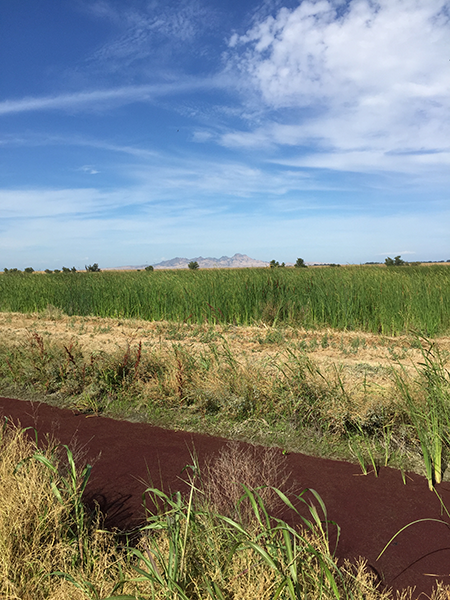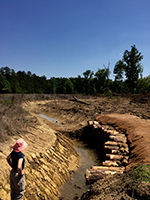|
 |
|
It's official, we're halfway through 2015.
It's been a very busy year so far at WES, as we've been working on several new projects, including the just-approved Grasslands Mitigation Bank in California, and Locust Fork Mitigation Bank in Alabama. Construction has been one of our primary focuses, and we have made progress with restoration activities at
Colusa Basin Mitigation Bank and
Canoe Creek Mitigation Bank. We are excited to share information about each project in this edition of Landscapes.
We have also been spending time traveling to various local, regional, and national conferences not only to introduce our company to potential clients, but also to connect with face-to-face with those we usually only have the pleasure of communicating with over the phone or via e-mail. We look forward to these conferences because they provide an opportunity to hear about your projects and share ideas.
If we missed the chance to connect at a conference this year, we would like to correct it - either at the next industry event, or by an "electronic exchange." Feel free to call us, email us, or join us on
Facebook,
Twitter, and
LinkedIn.
Thank you and enjoy your summer!

Greg Sutter
|
|
Grasslands Mitigation Bank is Approved!
|
 |
WES is pleased to announce the approval of Grasslands Mitigation Bank. Located in Merced County, the 281-acre bank lies within the Grasslands Ecological Area, the largest remaining contiguous block of freshwater wetlands in California. The project is also located adjacent to the Volta Wildlife Area, which supports a Giant Garter snake (
Thamnophis gigas) (GGS) population.
 The objective of the bank is to restore an ecologically appropriate, sustainable wetlands and uplands complex in place of existing hay and crop fields. The restoration design includes historic landforms, climate, hydrology, soils, and habitat needs of threatened and endangered species. The bank is approved by the U.S. Fish and Wildlife Service, California Department of Fish and Wildlife, U.S. Environmental Protection Agency, and the U.S. Army Corps of Engineers to offset unavoidable impacts to the GGS as regulated under both the federal and California Endangered Species Acts (ESA & CESA), and to jurisdictional freshwater wetlands (404 wetlands) regulated under Section 404 of the federal Clean Water Act. Credits from the project will provide regulatory relief for permit application in the lower San Joaquin Valley, where no bank is currently approved.
The GGS service area consists of the Northern Tulare Basin, San Joaquin Basin and a portion of the Sacramento San Joaquin Delta Recovery Units. The Wetlands Service Area includes the EPA level III ecoregion (California Central Valley) which lies within the two 6-digit HUC's encompassing the San Joaquin and Tulare Basins north of the Kings River.
To learn more about this and other WES banks please visit our website at
wesmitigation.com.
|
|
Building Giant Garter Snake and Seasonal Wetland Habitat at Colusa Basin Mitigation Bank
|
 |
 Construction is complete at our approved Colusa Basin Mitigation Bank in Colusa County. The restoration site adds 160 acres to the surrounding conservation landscape comprised of the Colusa National Wildlife Refuge to the north and other surrounding wetland conservation projects. The bank offsets unavoidable impacts to
Thamnophis gigas, the Giant garter snake (GGS) and to jurisdictional freshwater wetlands (404 wetlands).
Construction activities have restored and enhanced habitat that will support all life stages of the GGS in a managed-marsh complex, and also created 404 wetlands. To create the various habitat features, portions of the existing landscape were de-leveled, channels in the managed-marsh were cut, and the fill was used to create berms and upland refuge mounds. For the GGS habitat in the managed-marsh, existing and new water control structures will be used to adjust the water level, but not for the 404 wetlands which will be fed by rainfall and natural flooding.
The multi-benefit project provides habitat for both threatened and non-threatened species, such as migratory water fowl and otters, while improving water quality through the filtrating function of the wetlands.
Visit the
project page on our website for additional information on the bank.
|
|
Stream Restoration Underway at Canoe Creek Mitigation Bank
|
 |
 Restoration is underway at the 237-acre
Canoe Creek Mitigation Bank (CCMB), located in St. Clair County. The bank is ideally positioned within the Coosa River Basin as a site for wetland and stream habitat restoration and is permanently protecting and restoring structure and function to approximately 6,374 linear feet of stream and riparian buffer. In addition, wetland restoration activities include the following habitat types: hardwood forested, riparian hardwood forested, and hardwood forested slope.
These efforts meet conservation actions specified in the Alabama Comprehensive Wildlife Conservation Strategy (2005), to "improve water quality and habitat quality throughout the basin" and to "support habitat and riparian restoration."
Management strategies consist of the following: wetland restoration, wetland enhancement, and priority one in-stream restoration. Hardwood forested wetland restoration involves 84.8 acres; hardwood forested wetland enhancement involves 47.6 acres. In-channel stream restoration consists of 6,374 linear feet of priority one in-stream work.
Approximately 103,000 hardwood trees were planted at CCMB in February, 2015. Begun in October, 2014 and completed in June, 2015, the priority one in-stream construction involves new location stream design. Structures used for construction include toewood, rootwads, J hooks, and log vane structures.
The bank is approved by the U.S Army Corps of Engineers to provide wetland and stream credits in the Middle Coosa watershed for unavoidable impacts to waters of the United States which result from activities authorized under section 404 of the Clean Water Act.
CCMB's service area includes portions of Blount, Calhoun, Cherokee, Clay, Cleburne, Dekalb, Etowah, Jefferson, St. Clair, Shelby, and Talladega Counties that are within the Middle Coosa watershed (HUC 03150106) of the Coosa-Tallapoosa Basin. Mitigation outside of the 8 digit HUC will be allowed using the proximity multiplier method.
|
| California Red-Legged Frog Workshop Opportunity |
 WES is teaming with Dudek to offer a California Red-legged Frog workshop at Big Gun Conservation Bank in California on August 20, 2015.
The workshop offers a rare opportunity to learn about the identifying characteristics of the California Red-legged Frog and become familiar with the unique habitat features associated with the species.
To learn more about the workshop and to register please download the
event flyer.
|
|
WES Welcomes New Team Members
|
 |
WES is pleased to welcome new staff members to our team.
Southeastern Regional Office
Jason Martin has joined the Auburn office as a Project Planner. In this position, he provides technical support in the fields of biology, habitat restoration, land stewardship, and biological monitoring. Jason received his Bachelor of Science degree in Forestry with an emphasis in Land Management from Auburn University. He has worked on stream and wetland mitigation projects, as well as managed large tracts of land for multiple uses including threatened and endangered species.
In his free time, Jason enjoys waterfowl hunting and Auburn sports. Jason has a daughter and newborn son.
A newly-hired Business Development Representative, Kelly Sands plans and conducts outreach in the "panhandle" region of Florida to assist WES clients with meeting their mitigation requirements. Prior to joining WES, Kelly worked for an environmental consulting firm in San Rafael, California, where she specialized in credit sales management and marketing, mitigation bank entitlement, market analysis and feasibility studies. She has nearly a decade of experience in the mitigation and conservation banking industry.
Kelly received her Master of Science from the University of Georgia's Odum School of Ecology and her Bachelor of Science degree in Biology from Oglethorpe University in Atlanta. Incorporating a watershed approach into compensatory mitigation was the focus of her thesis. She attended the Property and Environment Research Center's Enviropreneur Institute in 2011, and has dedicated her career to promoting market-based solutions to natural resource conservation.
Kelly is a native of Georgia. She enjoys hiking, running, and exploring natural places with her dog Winston.
Western Regional Office
Tara Collins is a newly-hired Conservation Planner/Botanist in the entitlement division of Westervelt Ecological Services. Her primary responsibilities include coordinating with various State and Federal agencies to establish, permit, and manage properties proposed for new conservation and/or mitigation banks throughout California. Prior to joining WES, Tara worked for an environmental consulting firm in the Sacramento area and specialized in Clean Water Act Section 404 mitigation monitoring and compliance.
Tara received her Bachelor of Science degree in Botany from Humboldt State University in Arcata, California. She has a passion for California native plants and enjoys gardening at her home where she has over 75 species of native plants growing in her yard. Tara has 5 hens, 3 cats, and 3 beehives. In addition to growing native plants, she grows vegetables and hops, and enjoys watching the wildlife in her yard.
|
|
Credit Corner - Swainson's Hawk
|
 Several WES banks throughout northern California are approved by the California Department of Fish and Wildlife and local counties to provide Swainson's hawk credits to applicants who have project impacts to the Swainson's hawk under CEQA.
Credits purchased from an approved bank benefit both applicants and local agencies. The purchase of a credit includes:
- Severance of liability
- Long-term management and monitoring
- All costs associated with land, management, a financial endowment, and a recorded conservation easement
WES banks providing Swainson's hawk mitigation credits include:
To learn more about each bank and the Swainson's hawk impacts these credits cover, contact one of our Western Region staff.
Travis Hemmen or
Jeff Mathews at (916) 646-3644.
|
|
National Mitigation Banking Association and Ecosystem Conference
|
 |
The National Mitigation and Ecosystem Banking Conference was held May 5-8, 2015, in Orlando, Florida. 400+ attendees spent the week sharing ideas and experiences in mitigation banking.
Several WES staff members served as official conference presenters, and gave the following presentations:
- "Effective Communications in Banking - A Critical Key to Success," by Travis Hemmen, Business and Market Development.
- "Joint Agency Mitigation & Conservation Banks - Panel Discussion," with agency representatives and Greg DeYoung, Executive Vice President.
- "Long-Term Stewardship Workshop," with DeYoung and Bob Polin, Impact-Directed Environmental Accounts with the National Fish and Wildlife Foundation.
- "Mitigation and Conservation Banking - Primer Workshop 101," DeYoung; John Wigginton, Southeast Regional Manager; Craig Denisoff, Owner of Craig Denisoff Consulting; and Bob Brumbaugh, Deputy Director for the Institute for Water Resources with the U.S. Army Corps of Engineers.
- "Looking to the Landscape and Historical Resources Used to Determine Target Forest Type," by John McGuire, Project Manager.
To access these presentations, please visit:
http://www.eventscribe.com/2015/MitigationBankingConference/
|
|
|
|
 |
 |
|
|